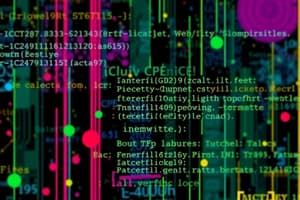Podcast
Questions and Answers
What is the type of the echo-request message?
What is the type of the echo-request message?
- 0
- 14
- 8 (correct)
- 13
What is the purpose of sending an echo-request message?
What is the purpose of sending an echo-request message?
- To check the host's reachability (correct)
- To calculate the round-trip time
- To synchronize the clocks in two different machines
- To learn the time on a remote computer
What is the type of the timestamp-reply message?
What is the type of the timestamp-reply message?
- 13
- 0
- 14 (correct)
- 8
What is the code of the timestamp-request and timestamp-reply messages?
What is the code of the timestamp-request and timestamp-reply messages?
What can be calculated using the timestamp-request and timestamp-reply messages?
What can be calculated using the timestamp-request and timestamp-reply messages?
What is the purpose of the ping command?
What is the purpose of the ping command?
What are the two debugging tools that use ICMP for debugging?
What are the two debugging tools that use ICMP for debugging?
What is required to synchronize the clocks in two different machines using the timestamp-request and timestamp-reply messages?
What is required to synchronize the clocks in two different machines using the timestamp-request and timestamp-reply messages?
What is the condition for calculating the round-trip time using the timestamp-request and timestamp-reply messages?
What is the condition for calculating the round-trip time using the timestamp-request and timestamp-reply messages?
Who can send a parameter problem message?
Who can send a parameter problem message?
What is the purpose of the redirection message?
What is the purpose of the redirection message?
What is the type of message for a parameter problem?
What is the type of message for a parameter problem?
What is the purpose of an echo-request message?
What is the purpose of an echo-request message?
Who can send an echo-request message?
Who can send an echo-request message?
What is the response to an echo-request message?
What is the response to an echo-request message?
What is the main purpose of ICMP Query messages?
What is the main purpose of ICMP Query messages?
When is a redirection message sent?
When is a redirection message sent?
What are the two types of messages used for error handling and debugging?
What are the two types of messages used for error handling and debugging?
What does the 'Type' field in the destination unreachable message specify?
What does the 'Type' field in the destination unreachable message specify?
What is the range of the 'Code' field in the destination unreachable message?
What is the range of the 'Code' field in the destination unreachable message?
What happens when the destination does not want to process the request?
What happens when the destination does not want to process the request?
What is the purpose of the source quench message?
What is the purpose of the source quench message?
What is the type of the source quench message?
What is the type of the source quench message?
What happens when the router is not able to handle the high data rate?
What happens when the router is not able to handle the high data rate?
What is the role of ICMP in the network layer?
What is the role of ICMP in the network layer?
What is the consequence of not having flow control and congestion control in the network layer?
What is the consequence of not having flow control and congestion control in the network layer?
What should the sender do when it receives a source quench message?
What should the sender do when it receives a source quench message?
What is the primary function of the Traceroute tool?
What is the primary function of the Traceroute tool?
What type of messages does Traceroute use?
What type of messages does Traceroute use?
What happens if the TTL value reaches zero?
What happens if the TTL value reaches zero?
Why does Traceroute use small TTL values?
Why does Traceroute use small TTL values?
What is the purpose of the TTL value in Traceroute?
What is the purpose of the TTL value in Traceroute?
What happens when the TTL value is 1?
What happens when the TTL value is 1?
What is generated by router 1 when the TTL value reaches 0?
What is generated by router 1 when the TTL value reaches 0?
What is the purpose of the example in the content?
What is the purpose of the example in the content?
What is the relationship between the TTL value and the router that generates the time-exceeded message?
What is the relationship between the TTL value and the router that generates the time-exceeded message?
What is the primary purpose of ICMP echo-request and echo-reply messages?
What is the primary purpose of ICMP echo-request and echo-reply messages?
Why is ICMP a connectionless protocol?
Why is ICMP a connectionless protocol?
What happens when a device is targeted by an ICMP flood attack?
What happens when a device is targeted by an ICMP flood attack?
What is the main goal of a ping of death attack?
What is the main goal of a ping of death attack?
Why is ICMP not associated with a transport layer protocol?
Why is ICMP not associated with a transport layer protocol?
What is the consequence of a device receiving a ping packet larger than the maximum allowable size?
What is the consequence of a device receiving a ping packet larger than the maximum allowable size?
What is the main difference between an ICMP flood attack and a ping of death attack?
What is the main difference between an ICMP flood attack and a ping of death attack?
Why is ICMP commonly used in DDoS attacks?
Why is ICMP commonly used in DDoS attacks?
What is a characteristic of ICMP that makes it vulnerable to DDoS attacks?
What is a characteristic of ICMP that makes it vulnerable to DDoS attacks?
Flashcards are hidden until you start studying
Study Notes
Destination Unreachable Message
- Type 3 specifies that the destination is unreachable
- Code (0 to 15) identifies whether the message comes from an intermediate router or the destination itself
- Code 2 or 3 indicates the destination creates the destination unreachable message
- The destination sends the destination unreachable message to the source if it does not want to process the request
Source Quench
- ICMP provides feedback to the sender to slow down the packet transmission rate
- The router sends a source quench message (Type 4, Code 0) to inform the sender to reduce the packet transmission rate due to congestion
- The sender must either stop or slow down the sending of datagrams until the congestion is reduced
Parameter Problems
- The router and destination host send a parameter problem message (Type 12, Code 0 or 1) to indicate improper parameter settings
Redirection
- Redirection message updates the routing table and informs the sender to use a better route
- The router sends a redirection message to the host on the same network
- The host updates its routing table to use the better route
ICMP Query Messages
- ICMP query messages are used for error handling and debugging
- Echo-request (Type 8, Code 0) and echo-reply (Type 0, Code 0) messages check host reachability and operation of IP protocol
- Timestamp-request (Type 13, Code 0) and timestamp-reply (Type 14, Code 0) messages calculate round-trip time and synchronize clocks
Debugging Tools
- Ping uses ICMP echo-request and echo-reply messages to check host reachability
- Traceroute tracks the route taken by a packet on an IP network from source to destination
- Traceroute uses ICMP messages and TTL values to determine the location of routers
How ICMP Works
- ICMP is a connectionless protocol and does not require a transport layer protocol (TCP/UDP)
- ICMP does not open a connection before sending a message
- ICMP does not allow targeting a specific port on a device
ICMP in DDoS Attacks
- ICMP flood attack: the attacker overwhelms a targeted device with ICMP echo-request packets, consuming its computing resources
- Ping of death attack: the attacker sends a ping larger than the maximum allowable size, causing the machine to freeze or crash
Studying That Suits You
Use AI to generate personalized quizzes and flashcards to suit your learning preferences.




